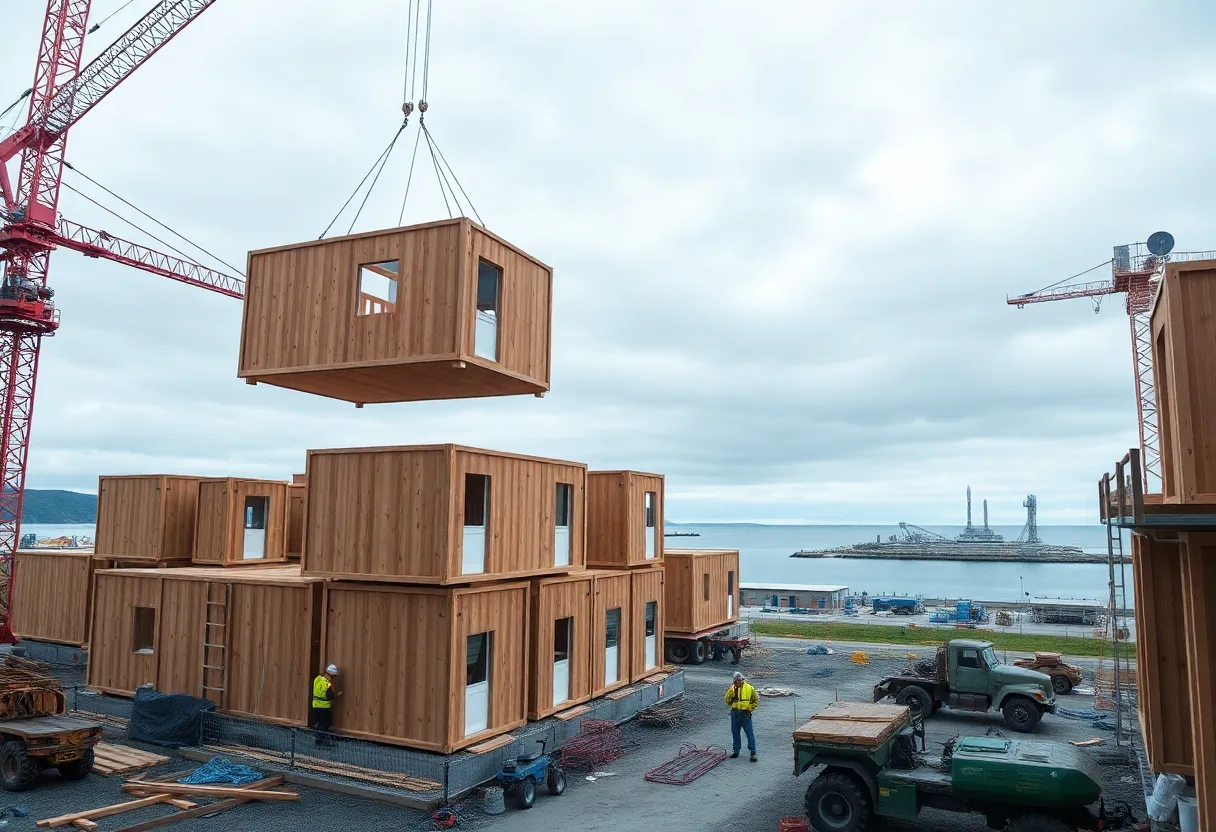Canada, August 19, 2025
News Summary
Canada’s housing sector is at a pivot point as affordability pressures persist despite modest productivity gains and faster modular build times. Builders report improved outcomes from AI, BIM and digital twins while offsite methods cut completion times and costs. At the same time, purpose-built rental development is cooling as institutional returns fall and financing tightens. Regional activity is uneven—Montreal and prairie centres see multi‑unit growth while Toronto and Vancouver face slumps. Atlantic provinces are refocusing immigration on key occupations, and a private spaceport project in Newfoundland signals new industrial investment alongside housing policy efforts to boost supply.
Canada’s housing and construction crossroad: modest productivity gains, modular wins, rental pullbacks, regional starts surge, Atlantic immigration shifts, and a new Newfoundland spaceport
Top line: Canada faces a housing affordability crisis even as modest productivity gains and wider use of modular building are speeding some projects and creating investor opportunities. At the same time, rental developers are pulling back because returns and rents have weakened in major markets, regional building starts are diverging sharply, Atlantic provinces are reprioritizing immigration streams for priority jobs, and a private company has begun building a new launch complex in Newfoundland that aims to support both suborbital and orbital activity.
Productivity and technology — small gains, big promise
Construction productivity is rising slowly, creating an opening for investors and builders that adopt new tools. The Canada Construction Labour Productivity Index stood at 92.47 as of March 2025, reflecting a 2.15% year-over-year gain, with 2007 used as the base year (100). Canada still trails the U.S. on construction productivity, a gap linked to weak uptake of advanced technologies and a fragmented small and medium enterprise landscape.
Surveys and project examples show tech matters. A large share of industry leaders see tools like AI, Building Information Modelling (BIM), and digital twins as essential, and many companies report measurable gains after investing. AI-driven design checks and IoT sensor networks are cutting costly errors, and digital twins are being used for predictive maintenance and risk forecasting. In projects that used offsite methods, such as one modular lodge in Regina, build time dropped dramatically: the Horse Dance Lodge was completed in 12 months, and modular techniques have been shown to reduce build-to-occupancy times by up to 40% on some supported projects.
Rental development chills and capital rebound challenges
Several large landlords and developers are changing strategy after years of rising interest rates and falling rents in markets like Toronto and Vancouver. A major developer that launched a residential division in 2018 to pivot into purpose-built rental towers announced in May 2025 plans to sell its existing rental buildings and largely exit residential development, switching to a funding model that relies on outside investors to provide most capital while it contributes land and expertise. Institutional investors have been put off by shrinking returns on rental development, with industry estimates of returns as low as 4.5% annually. Development yields at that level make projects less attractive compared with other options.
Other headwinds are visible. Falling rents in Toronto and Vancouver have harmed financing and return projections, many development costs remain sticky, and rents have come in below projections with little rebound expected for several years. Public statistics that count projects rising above ground can overstate the pipeline: consultants and developers tracking earlier-stage work report rental starts have dropped by around 60% recently, even as some public figures show overall starts flourishing.
Regional starts and the ownership market
National housing starts surged in July to a seasonally adjusted annualized pace of 294,100 units, a 3.7% increase from June and higher than most analysts expected. In population centres of 10,000-plus, actual starts increased by 4% in July, with construction beginning on 23,464 units. The year-to-date total rose 4% versus the first seven months of 2024.
That headline growth masks sharp regional divergence. Montreal’s starts jumped by 212%, driven by a large multi-unit surge, while Toronto recorded an overall slump of 69% compared with the same period last year as both multi-unit and single-detached starts fell. Analysts warn the elevated national figures reflect investment decisions made months or years earlier, and building permits suggest starts could stay near current levels in the near term but cool in 2026 as population growth slows and asking rents fall in some areas.
Housing supply mix and renter market pressures
A sudden rise in condo completions and new rental buildings has given renters more choices in some markets. Two-thirds of recently developed rental buildings in the Greater Toronto Hamilton Area now offer incentives such as two months free rent and free parking. Land costs have begun to fall in places: zoned land for multifamily properties can be bought for about half what it cost two years ago in some situations. Construction costs are starting to come down too, but municipal development charges remain a sticky cost that can sway project yields. Owners of existing rental buildings were able to raise rents substantially at turnover in the cited period, showing a split between standing stock and new supply.
Policy moves to lift output and support rental construction
The federal government has a $129 billion housing plan that includes creating a new program called Build Canada Homes and aims to double construction output to 500,000 units annually by 2030. The plan prioritizes modular construction and mass timber and includes measures such as scrapping the GST on new buildings and providing low-cost construction financing through the national mortgage agency. Some provinces are trimming development charges for multi-unit housing or removing GST on homes under $1 million as local incentives. These measures aim to make productivity-driven approaches and modular builds more attractive.
Atlantic Immigration Program reprioritization
With a reduced allocation for 2025, Atlantic provinces are prioritizing certain occupations under the Atlantic Immigration Program. Healthcare, construction, manufacturing and select other sectors are more likely to be favored for endorsements in 2025. The AIP remains an employer-driven route to permanent residence that requires a job offer from a designated employer and provincial endorsement; it offers faster processing and access to LMIA-exempt work permits that let successful candidates work while their PR application is processed. Several provinces have tightened priorities: Prince Edward Island limited endorsements to a small set of high-demand sectors, Nova Scotia prioritized in-province workers with expiring permits and those in healthcare and construction, and Newfoundland and Labrador moved to an Expression of Interest model for its PNP and AIP effective Feb. 19, 2025. One unnamed province paused its AIP for the rest of the year after reaching its allocation on April 4. New Brunswick received an additional 1,500 PNP spots in June 2025.
Newfoundland spaceport and domestic launch capability
A private Canadian firm began construction on an Atlantic Spaceport Complex near the town of St. Lawrence, Newfoundland and Labrador. The introductory $10 million phase includes two facilities: Space Launch Complex-01 with two pads for orbital rockets and Space Launch Complex-02 to support suborbital flights and tracking infrastructure for space domain awareness. The site is positioned to enable orbital inclinations between 46° and 100°, giving it a wide set of launch trajectories. The first suborbital rocket mission has an official launch window opening on Aug. 25 and will be a low-altitude demonstration powered by a 3D-printed engine; an orbital vehicle under development aims for capability comparable to a small dedicated launcher and has a target for first orbital missions in the mid-to-late 2020s. The spaceport work was built from Canadian sources, and the company projects nearly 650 jobs and $2.5 billion in economic activity through 2035. A correction notes the site is not the country’s first commercial launch site and that another Atlantic company began construction on a different facility in 2023 and has hosted at least one suborbital mission.
Investor takeaways and risks
Investors should watch construction firms that adopt AI, BIM, digital twins and modular methods early, as these players are positioned to outperform peers. A model suggests that a 1% fall in unit labour costs from productivity improvements could translate into a 1.2% reduction in home prices, demonstrating how operational gains can ripple to buyers. But risks remain: regulatory delays, labour shortages and high development charges can undercut returns. Workforce development initiatives such as apprenticeships and diversity programs will be critical to sustain momentum.
Bottom line
Canada’s housing market stands at a crossroads. Modest productivity gains and modular construction offer a path to faster, cheaper builds, while regional demand patterns, investor pullbacks in rental development and changing immigration priorities will shape supply. Those who move early into productivity-driven construction solutions and target growing regions or effective public-private partnerships are likely to capture long-term value, but near-term challenges and policy execution will determine whether the promise turns into results.
Frequently Asked Questions
What is driving the recent rise in construction productivity?
How much did the Canada Construction Labour Productivity Index change?
Why are some rental developers exiting or slowing projects?
What changed in Atlantic immigration for 2025?
What is the new spaceport project in Newfoundland?
Key features at a glance
| Topic | Key facts | Numbers to note |
|---|---|---|
| Construction productivity | Modest gains driven by AI, BIM, digital twins and modular methods | Index 92.47 (Mar 2025); +2.15% YoY; base year 2007=100 |
| Federal housing plan | New Build Canada Homes and focus on modular, mass timber | $129 billion plan; target 500,000 units/year by 2030 |
| Rental market & developers | Developers pulling back; institutional capital harder to find | Returns as low as 4.5%; rental starts tracking down ~60% at early stages |
| Housing starts | National surge with big regional differences | 294,100 annualized (July); Montreal +212%; Toronto -69% |
| Atlantic Immigration Program | Prioritization of healthcare, construction and manufacturing in 2025 | One province paused AIP after hitting allocation; New Brunswick +1,500 PNP spots |
| Spaceport | New Atlantic Spaceport Complex under construction in Newfoundland | $10M initial phase; 2 launch complexes; launch window Aug. 25 for suborbital demo |
Deeper Dive: News & Info About This Topic
Additional Resources
- The Globe and Mail: Rental-apartment construction, developers and market shifts
- Wikipedia: Construction industry of Canada
- MSN: Prairie housing starts drive Canada-wide residential construction increase
- Google Search: Canada housing starts prairie provinces 2025
- Space.com: Canada’s 1st commercial spaceport is under construction
- Encyclopedia Britannica: Spaceport
- CIC News: Atlantic Immigration Program — priorities for 2025
- Google Scholar: Atlantic Immigration Program 2025 labour market
- ConstructConnect: Canada’s in need of a contech and proptech revolution
- Google News: contech proptech Canada 2025
Author: Construction CA News
The CALIFORNIA STAFF WRITER represents the experienced team at constructioncanews.com, your go-to source for actionable local news and information in California and beyond. Specializing in "news you can use," we cover essential topics like product reviews for personal and business needs, local business directories, politics, real estate trends, neighborhood insights, and state news affecting the area—with deep expertise drawn from years of dedicated reporting and strong community input, including local press releases and business updates. We deliver top reporting on high-value events such as the Rose Parade, Coachella, Comic-Con, and the California State Fair. Our coverage extends to key organizations like the California Building Industry Association and Associated General Contractors of California, plus leading businesses in technology and entertainment that power the local economy such as Apple and Alphabet. As part of the broader network, including constructionnynews.com, constructiontxnews.com, and constructionflnews.com, we provide comprehensive, credible insights into the dynamic landscape across multiple states.




